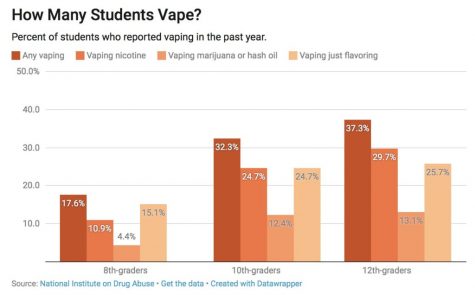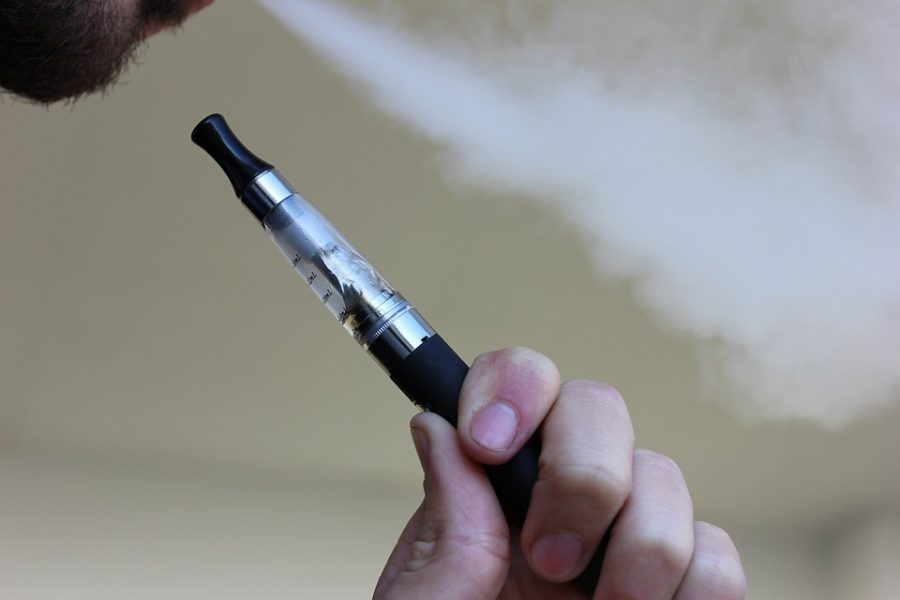Vaping-Related Illnesses Plague the Nation
An epidemic of vaping-related lung diseases is spreading across the nation, leaving eight dead, hundreds ill, and millions shocked and looking for answers. The CDC says those numbers are only going to rise. What does this mean for e-cigarette users nationwide, or in our own school?
September 24, 2019
An outbreak of lung illnesses linked to the use of e-cigarettes has swept the nation, already killing eight people. The CDC recently reported 530 confirmed and probable cases in 36 states, but those numbers may be higher, as 45 state health departments have already called for the investigation of over 700 more possible cases. In early July, the first case of a vaping-related lung injury was reported in Utah, and by the end of the month, eleven more people grew ill. The tally took a grave leap as the number increased from 12 to 215 known cases in August. As more people fell ill, more symptoms were discovered, indicating the highly diverse nature of the illness. The most common symptoms include coughing, trouble breathing, chest pain, fever, general fatigue, and diarrhea. Some patients have needed surgery and have been placed in intensive care units or on ventilators. As far as the CDC and FDA know, the illness does not originate from a single vape product, but most cases involve the use of THC and cannabis oil.
Recreational marijuana is illegal in the majority of the United States, but that does not stop millions of people from using it. It is well-understood that known manufacturers follow strict regulations, but there exists a vibrant black market for cannabis products, which can easily be made from toxic and dangerous chemicals or liquids. Many purchase these “bootleg” vape pen cartridges, which are widely believed to be the culprit of the lung illnesses. The focus of the FDA and CDC’s investigation is the unregulated black market supply, which is undoubtedly inundated with adulterants to cheapen the products.

A 2018 survey conducted by the National Institute on Drug Abuse shows that 25.7% of high school seniors have admitted to using any type of vape, while 13.1% have admitted to vaping marijuana. According to the CDC, 16% of people affected by the illness are under the age of 18. Taking into consideration these statistics and the amount of anti-vaping posters hung around our building, as harrowing as it sounds, a student from the school could be the next victim of the vaping-related lung illness.
Student Assistance Counselor Ms. Gould is extremely knowledgeable in vaping and drug use in teenagers and has shared her thoughts on this national epidemic and what it could mean for students here. “I would hope that the amount of e-cigarette users here would drop,” Gould stated. “I have spoken to a few students this year who have told me that, as of now, they do not believe it has dropped significantly, but with all the news coming out and hopefully more education to be provided, it will be a deterrent for students to stop.” This outbreak could encourage people, both teenagers and adults, to quit, but it will most certainly not be an easy task. “I have counseled students who are very addicted to the nicotine volume they had become accustomed to smoking,” said Gould. ”When each pod equals approximately one pack of cigarettes and you are mindlessly continuing to ‘hit the vape,’ it can result in your body getting used to a lot of nicotine, and it is addictive, so then it becomes a very hard habit to break.”

















































































































































